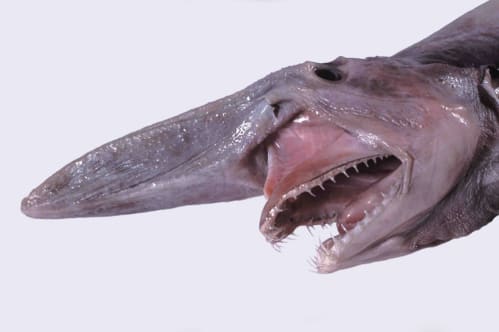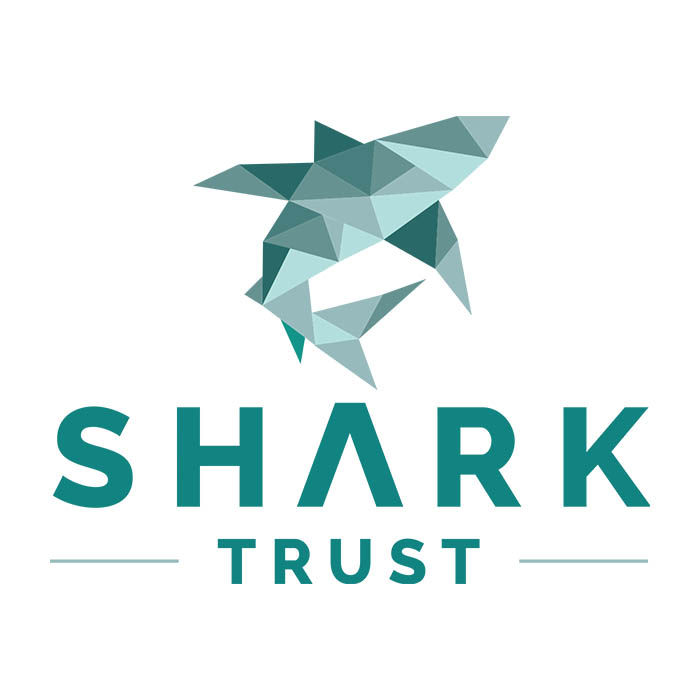Marine Life & Conservation Blogs
Creature Feature: Goblin Shark

 In this series, the Shark Trust will be sharing amazing facts about different species of sharks and what you can do to help protect them.
In this series, the Shark Trust will be sharing amazing facts about different species of sharks and what you can do to help protect them.
Written by guest contributor – Yolanda Evans.
Mysteriously slithering around the dark mesopelagic of the western Pacific, the glorious Goblin shark swims in search for their next meal. This illusive shark is one of the most unique-looking sharks to ever exist, having a long snout called a rostrum and protrusible jaws, hailing them their common name, Goblin. Their rostrum is covered with small pores called the ampullae of Lorenzini, jelly-filled pores in the snouts of many sharks that are able to pick up changes in the electro-magnetic field, for example the muscle contractions of nearby fish. However, these pores can only detect movement only a few inches in front of the shark!
In addition to their rostrum, these sharks poses and amazing ability to protrude their jaws out or their cartilaginous skull by something called slingshot feeding. This is when the jaws are shot forward, extending 8.6-9.4% of the Goblin sharks total body length. However, this fast jaw action also creates a powerful suction-known as a pharyngeal suction-forcing their prey deeper into their mouths.
While many sharks range from greys to blues to browns, this stupendous shark can be a very pale pink! However, this unusual colour is not from a pigment in their skin, but from the thinness of their skin! Their skin has such a great transparency that the oxygenated blood that flows in their capillaries-tiny blood vessels-causes what would be their grey skin, to become pink. This amazing ability might actually been an adaptation for the shark, they live 270m-1300 m deep, red light wavelengths cannot be seen, making the spectacular shark near invisible to both prey and predators!
Their scientific name, Mitsukurina owstoni, comes from the British naturalist Alan Owston who is credited with discovering the shark, and from Kakichi Mitsuriki, the Japanese scientist who identified and described the shark. While the English common name is only from their long rostrum, the direst translation into Japanese is Tengu-zame, base of the Tengu, a Japanese mythological half-man-half-bird who had red skin and a long nose, a comparison more fitting.
Despite their somewhat intimidating appearance, the Goblin shark is not an aggressive species, predating on mainly small bony fish, crustaceans, and cephalopods. Long slender teeth that protrude out from their jaws, appearing almost like blades, are perfect for clutching onto their prey. Nonetheless, the most threat they create towards humans is disrupting our internet as they are known to bite down onto submarine cables!
Like many other shark species, Goblin sharks main threat is by-catch from deep-sea longlining and deep-sea trawling. They are listed by the IUCN as least concern. Unfortunately, being relatively understudied, this may be incorrect as there is a very minimal amount of knowledge about the lives of these sharks. Leaving the question: what else is there to know about the truly incredible Goblin shark?
SCIENTIFIC NAME: Mitsukurina owstoni
FAMILY: Mitsukurinidae
MAXIMUM SIZE: Up to 3.8 meters (12.5 feet) in length
DIET: Feeds primarily on deep-sea fish, but also crustaceans and cephalopods
DISTRIBUTION: Goblin Sharks have a wide but patchy distribution, found in deep waters of the Atlantic, Indian, and Pacific Oceans.
HABITAT: Primarily found in the deep sea, typically between 200 and 1,200 meters (656 and 3,937 feet) in depth. They are occasionally seen at shallower depths, but are typically associated with steep slopes and canyons on the continental shelf and slope.
CONSERVATION STATUS:
Due to their deep-sea habitat and elusive nature, they are rarely encountered and little is known about their population trends. However, they are sometimes caught as bycatch in deepwater fisheries, and there is concern over the potential impacts of deep-sea mining activities on their habitat.
Images – www.fishesofaustralia.net.au/home/species/3254 | Wikimedia Commons
Blogs
Saba’s Plan for a Coral Comeback

Saba has an exciting new initiative to restore its coral reefs. This new project, running from 2024 to 2026, will focus on reviving key species in the island’s underwater ecosystems. With a collaborative team from the Saba Conservation Foundation (SCF) and Van Hall Larenstein (VHL) University of Applied Sciences, the project aims to restore both corals as well as sea urchins.
This initiative is centered around coral restoration, specifically reviving two essential coral species—staghorn coral (Acropora cervicornis) and elkhorn coral (Acropora palmata). By mapping parent colonies and using a technique known as coral gardening, SCF will create and maintain coral nurseries. These corals will eventually be outplanted at key reef sites around Saba to not only expand the number of coral colonies, but also provide essential fish habitat. The project focusses on installing coral nurseries, training staff with the newest techniques and starting with the restoration of key reef sites.

Reef Cleaners to the Rescue
It’s not just corals getting a makeover—this project also shines a spotlight on the essential role of grazers, particularly sea urchins. VHL is leading the charge on cultivating and restocking two key sea urchin species, West Indian sea egg (Tripneustes) and long-spined sea urchin (Diadema), known for their ability to keep algae in check. By removing algae, which are important competitors of corals, they help the coral to thrive. By restoring these “reef cleaners,” Saba’s project will give corals the breathing room they need to grow, setting the stage for a healthier, more balanced marine ecosystem.
From Tiny Urchins to Big Goals
The project will be funded as part of the Dutch Government’s Nature and Environment Policy Plan (NEPP) 2020-2030 for the Caribbean Netherlands, a comprehensive initiative aimed at conserving and restoring the unique natural environments of the Dutch Caribbean islands, including Saba, St. Eustatius, and Bonaire. This project is aiming for big milestones: build and maintaining coral nurseries, the expansion of urchin cultivation facilities, and the creation of a dedicated research center. By 2026, the project hopes to ramp up coral and grazer restoration, with the ultimate goal of extending these efforts across the Dutch Caribbean. By linking local initiatives to broader regional goals, Saba’s restoration project promises to leave a lasting impact on both the environment and the community.
Find out more about the DCNA at dcnanature.org.
Blogs
Reef-World marks two decades of marine conservation: strengthening impact amid coral reef threats

Empowering ocean stakeholders to tackle future challenges and ensure the survival of coral reefs and humanity
2024 marks the 20th Anniversary of The Reef-World Foundation’s tireless efforts for global coral reef conservation. The UK charity is the international coordinator of the UN Environment Programme’s Green Fins initiative, known as the leading voice in sustainable marine tourism. Today, Reef-World released its 2023-2024 Impact Report outlining a year of substantive growth and impact in its marine conservation programmes.

Impact Report Highlights:
- Impressive improvements in environmental behaviours to protect coral reefs by the marine tourism industry as the global participation of Green Fins increases.
- Continued capacity building for government and NGO staff to effectively manage marine tourism activities in Asia, Caribbean and Red Sea regions.
- For the first time in Green Fins’ 20-year history, tourism operators have achieved ‘Best Environmental Performer’ status by demonstrating the lowest possible environmental impact in their environmental assessments. In 2024, three dive operators achieved this challenging milestone.
- Significant increases in global participation of Reef-World’s innovative digital conservation tools.
- 138 Green Fins dive operator members achieved the strict threshold for PADI Eco Center recognition.
- Developed four new educational materials and translated two into 16 languages to support the marine tourism industry in achieving sustainability targets.
- Establishing a new Reef-World Development strategy and recruiting new roles – Development and Programmes Managers.
- Reef-World’s board welcomes new Chair and Trustees strengthening organisational leadership.

Reef-World started as a one-person mission to inspire and empower communities to act in conserving and sustainably developing coral reefs and related ecosystems. Today, the team of 12 continues to meet this mission by inspiring and empowering the global marine tourism community to be exemplary sustainability leaders by using the Green Fins guidelines and tools to simultaneously use and protect the world’s precious reefs.
In April 2024, the fourth global coral reef bleaching event was confirmed. Reef-World’s work has never been more urgent as the marine environment, and the benefits they provide humanity, continue to be eroded by global threats. The reduction of local threats, like those from the marine tourism industry, is an essential step to ensuring a future where coral reefs survive and continue to support the millions of people who depend on their ecosystem benefits. Reef-World’s work buys time for coral reefs and related ecosystems to be resilient to the impacts of global threats.
“Right now our corals are facing the greatest fight of their existence as the terrifying predictions of the steps towards their complete extinction are starting to come true. But all is not lost, reefs are resilient and they have existed on this planet for millions of years. We must take action now, to buy time for reefs by reducing threats facing them and allowing them to react and adjust to the changing environment they need to survive in.” – Chloe Harvey, Executive Director
Looking Forwards:
Like coral reefs, the Reef-World team needs to be resilient in the face of the complex challenges of the conservation sector. Reef-World has invested significantly in developing a Culture of Care to ensure the well-being of its team on a daily basis, continuing to be an exemplary employer to enable its team to best achieve the mission for coral reef conservation.
With the foundations of a Culture of Care and organisational development laid, Reef-World is emerging from the end of a natural organisation life cycle, that brings the challenges of growth and scale, stronger than ever. With a new strategy in place to generate much needed resources, Reef-World is excited for the opportunities to leap forward, continue to scale our impact and lean into new innovations and untapped opportunities for marine conservation.
We continually strive to become a forward-thinking organisation that delivers on our goals and commitments to our stakeholders with fresh approaches and not being afraid of steering away from a “normal approach.” This approach is not only applied to our programmes of work but also internally and carries over to our Culture of Care for our team.” — JJ Harvey, Operations Director

The Reef-World Foundation is immensely grateful for the continued support of its grant funders: UN Environment Programme, IUCN’s Blue Natural Capital Financing Facility, Adventure Travel Conservation Fund, PADI Aware Foundation, and World Nomads Footprints Program.
Reef-World would also like to express its gratitude to international partners whose vital support has resulted in significant tangible benefits for our work and mission: PADI; Professional SCUBA Schools International (PSS); Explorer Ventures; 1% for the Planet; ZuBlu; Snorkel Venture, GSTC; Dive O’Clock; Seven Dragons; DiveAssure and Eco Beach, without whom these achievements would not be possible.
The full 2023–2024 Annual Impact Report is available on Reef-World’s website.
-

 News2 months ago
News2 months agoIconic SS United States to become the World’s Largest Artificial Reef
-

 News3 months ago
News3 months agoBook Review – 52 Assignments: Underwater Photography
-

 Gear News3 months ago
Gear News3 months agoDYNAMICNORD – New German diving brand enters the British market
-

 News3 months ago
News3 months agoExploring Cenote El Pit: A Diver’s Dream
-

 Gear News3 months ago
Gear News3 months agoTry BARE drysuits (and maybe even win one!) this Friday with Sea & Sea at North West Dive Fest
-

 Marine Life & Conservation3 months ago
Marine Life & Conservation3 months agoBook Review: Coral Triangle Cameos
-

 Blogs2 months ago
Blogs2 months agoDive the Egyptian Red Sea this Autumn with Regaldive
-

 News3 months ago
News3 months ago2024 Ocean Art Underwater Photo Competition Announced















